Contemporary Black Art in 28 Images
28 Outstanding Contemporary Black Artists for Black History Month
Tomorrow is the last day of Black History Month (in the U.S.). And even though we here at the Epicurean Vagabonds strongly believe that every month should be Black History Month (and every single week here we have chosen to actively celebrate the contributions of Black artists, writers, musicians, philosophers, directors, actors, activists, choreographers and chefs), we still wanted to mark this month with a brief tour of the amazing contemporary art scene. African-American artists, African artists, and artists from throughout the African Black Diaspora are creating some of the most exciting, interesting, provocative and meaningful art in the contemporary scene right now. To honor a handful of these artists, below are 28 images from 28 different contemporary Black artists, one for each day of Black History Month. Take a look at their stunning work, check out their official websites/galleries/shops, and let’s celebrate these artists all year round!
Juliana Huxtable: Untitled (Psychosocial Stuntin’), 2015. Color inkjet print. 40 × 30 in.
“In her work, Huxtable explores the intersections of race, gender, queerness, and identity. She uses a diverse set of means to engage these issues, including self-portraiture, text-based prints, performance, nightlife, music, writing, and social media.” (Guggenheim)
Instagram / Soundcloud / Artsy
Mickalene Thomas: Girlfriends and Lovers, 2008. Acrylic, enamel and rhinestones on panel. 108 × 144 in | 274.3 × 365.8 cm.
“New York-based artist Mickalene Thomas is best known for her elaborate paintings composed of rhinestones, acrylic and enamel . . . Not only do her masterful mixed-media paintings, photographs, films and installations command space, they occupy eloquently while dissecting the intersecting complexities of black and female identity within the Western canon.” (Official Site)


Official Site of Mickalene Thomas / Instagram / Artsy
Kehinde Wiley: Randerson Romualdo Cordeiro, 2008. Oil on canvas. 48 × 36 in | 121.9 × 91.4 cm.
“Kehinde Wiley restages classical portraits and sculptures, replacing historical white subjects with contemporary subjects of color. His lush, narratively rich canvases draw on textile patterns and the compositional tenets of Old Masters such as Peter Paul Rubens and Jacques-Louis David. Embracing ornate decorative elements, Wiley dignifies his subjects and subverts the whiteness that has long dominated Western art history.” (Artsy)

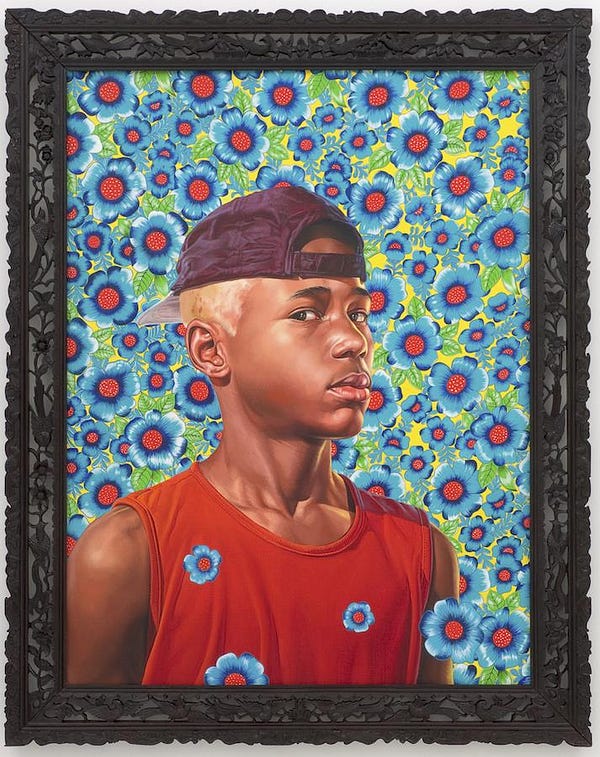
Official Site of Kehinde Wiley / Instagram / Artsy
Julie Mehretu: Stadia II, 2004. Ink and acrylic on canvas. 107 2/5 × 140 1/10 × 2 1/5 in | 272.73 × 355.92 × 5.71 cm.
“For more than two decades, Julie Mehretu (b. 1970, Addis Ababa, Ethiopia) has been engaged in a deep exploration of painting. She creates new forms and finds unexpected resonances by drawing from the histories of art and human civilization—from Babylonian stelae to architectural sketches, from European history painting to the sites and symbols of African liberation movements.” (Whitney Museum of American Art)
Julie Mehretu at Marian Goodman Gallery / Instagram / Artsy
Wangechi Mutu: Water Woman, 2017. Bronze. 36 x 65 x 70 in.
“In a practice that spans painting, sculpture, collage, film, and installation, Wangechi Mutu explores the violence and misrepresentations that afflict contemporary women—Black women, in particular. The effects of globalization and consumerism are also frequent themes. Contorted feminine forms, which seem simultaneously futuristic and primordial, appear throughout Mutu’s mythical bronzes and bricolages of paint, ink, magazine cutouts, and found materials.” (Artsy)

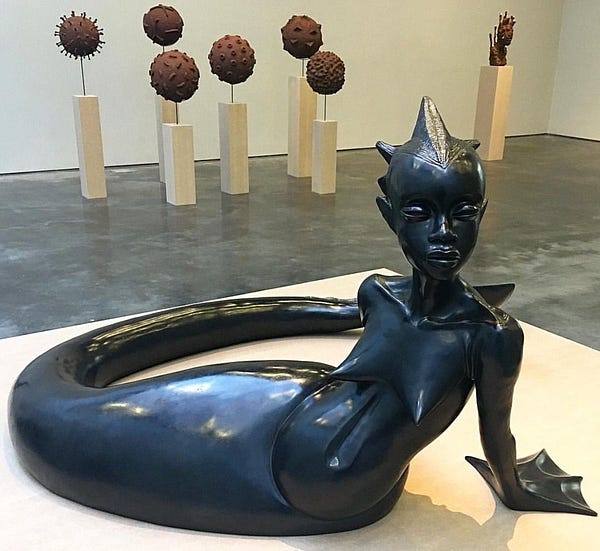
Wangechi Mutu at Saatchi Gallery / Instagram / Artsy
Yinka Shonibare: Woman Shooting Cherry Blossoms, 2019. Unique fiberglass sculpture, Dutch wax printed cotton textile, bespoke hand-colored globe, steel, brass, zamak, wood, resin, and silk. 244 x 193 x 436 cm.
“His interdisciplinary practice uses citations of Western art history and literature to question the validity of contemporary cultural and national identities within the context of globalisation. Through examining race, class and the construction of cultural identity, his works comment on the tangled interrelationship between Africa and Europe, and their respective economic and political histories.” (Official Site)
Official Site of Yinka Shonibare / Instagram / Artsy
Zanele Muholi: Bona, Charlottesville, 2015. Gelatin silver print. 35 1/4 × 24 in | 89.5 × 61 cm.
“Zanele Muholi is one of the most acclaimed photographers working today, and their work has been exhibited all over the world . . . Muholi describes themself as a visual activist. From the early 2000s, they have documented and celebrated the lives of South Africa’s Black lesbian, gay, trans, queer and intersex communities.” (Tate Modern)
Zanele Muholi at Yancey Richardson / Instagram / Artsy
Bisa Butler: Asantewa, 2020. Quilted and appliquéd cotton, silk, wool, and velvet. 52 x 88 in | 132.1 x 223.5 cm.
“Bisa Butler is an award winning African American textile artist. She is known for her vibrantly stunning larger than life sized quilted portraits that captivate viewers around the world.” (Official Site)
Official Site of Bisa Butler / Instagram / Artsy
Harmonia Rosales: Creation of God, 2017. Oil on Belgian linen. 48 x 60 in.
“Since the genesis of her career, Harmonia Rosales’s main artistic concern has focused on Black female empowerment in Western culture, depicting and honoring the African diaspora. . . . Nourished by her multicultural Afro-Cuban background, the Black female subjects in Rosales’s paintings are in memory of her ancestors and function as a way to heal and promote self-love.” (Official Site)


Official Site of Harmonia Rosales / Instagram
Aboudia: Les Yeux “Pop”, 2017. Mixed media on canvas. 40 × 60 in | 101.6 × 152.4 cm.
“Aboudia draws inspiration from local street culture in his hometown Abidjan, Ivory Coast. The artist is noted for his heavily layered, brutally energetic paintings that combine an innocence and spontaneity with the portrayal of a dark interior world. Since the Ivorian civil war in 2011, his urban landscapes have been haunted by trauma; armed soldiers, ominous skulls and a populace hemmed in by danger.” (Jack Bell Gallery)


Aboudia at Jack Bell Gallery / Instagram / Artsy
Gee’s Bend Quilters. Mary Lee Bendolph: Grandma Strips, 2009. Cotton. 75 x 77 in.
“Mary Lee Bendolph is one of the foremost strip quilters associated with Gee’s Bend, Alabama, a rural African American community located in a remote bend of the Alabama River and surrounded on three sides by water. . . . Strip quilting is a form of piecework quilting that can be traced back six generations in Gee’s Bend. Bendolph’s striking compositions use varying lengths of found and salvaged cloth to create discontinuous patterning and startlingly bold color arrangements. In embracing abstraction, her configurations exemplify the stark originality of Gee’s Bend quilters.” (MoMA)

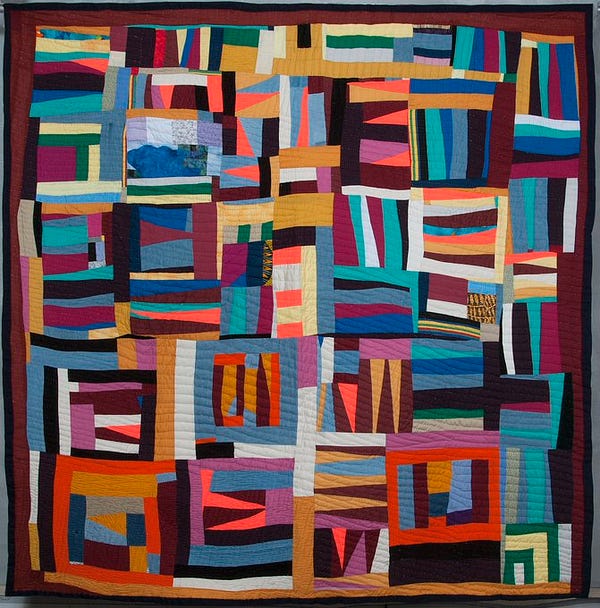
Official Site of the Gee’s Bend Quilters / Official Site of Mary Lee Bendolph / Artsy
Kudzanai Chiurai: We Live in Silence XIIII, 2017. Pigment inks on fiber paper. 59 1/10 × 76 1/5 in | 150 × 193.5 cm.
“In his pointed, theatrical multimedia compositions, Kudzanai Chiurai tackles government corruption, xenophobia, displacement, inequality, and other pressing issues for his generation of southern Africans. Chiurai’s visceral and expressionistic paintings, mixed-media works, photography, and videos reflect an interplay between history and modernity, colonialism and independence.” (Artsy)


Official Site of Kudzanai Chiurai / Artsy
Kadir Nelson: Say Their Names, 2020. Cover illustration for The New Yorker, June 22, 2020. Oil on linen. 36 x 48 in.
“An accomplished award-winning illustrator, painter, and author, Kadir Nelson is one of the most celebrated visual commentators of our time. His monumental, humanistic artworks appear on the covers and pages of popular magazines and books, and on posters, postage stamps and album covers, inspired by life’s large and small moments, by the complexities of American history, and by the African American experience, which he shares prominently and with dignity in his art.” (Norman Rockwell Museum)

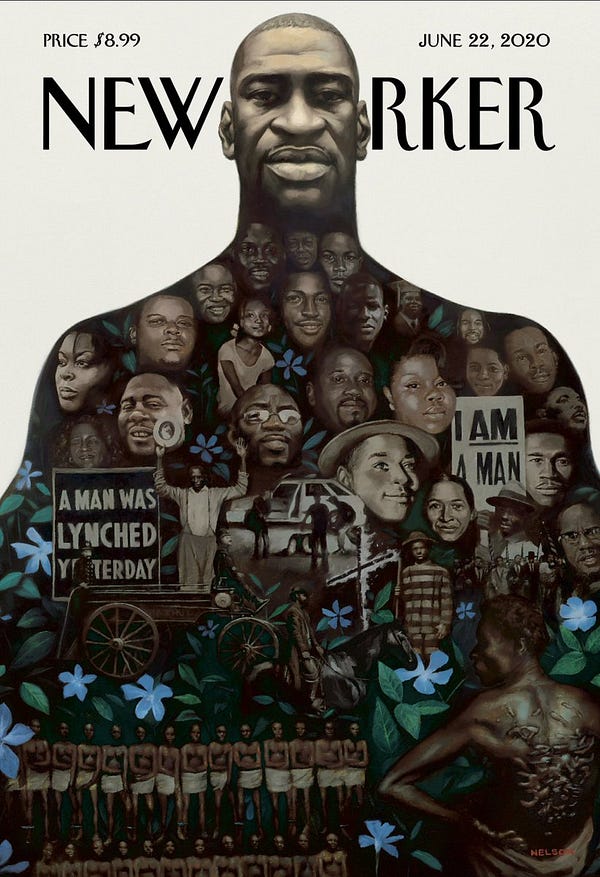
Official Site of Kadir Nelson / Instagram
Leilah Babirye: Nansamba II from the Kuchu Ngabi (Antelope) Clan, 2021. Glazed ceramic, bicycle tyre inner tubes and found objects. 48 × 29 × 31 in | 122 × 73.7 × 78.7 cm.
“Leilah Babirye’s multidisciplinary practice transforms everyday materials into objects that address issues surrounding identity, sexuality and human rights. The artist fled her native Uganda to New York in 2015 after being publicly outed in a local newspaper. . . . The artist also frequently uses traditional African masks to explore the diversity of LGBTQI identities, assembling them from ceramics, metal and hand-carved wood; lustrous, painterly glazes are juxtaposed with chiselled, roughly-textured woodwork and metal objects associated with the art of blacksmithing.” (Stephen Friedman Gallery)


Leilah Babirye at Stephen Friedman Gallery / Instagram / Artsy
Kara Walker: The Jubilant Martyrs of Obsolescence and Ruin, 2015. Cut paper on wall. 420 x 1775 cm | 165 3/8 x 698 7/8 in.
“Kara Walker is among the most complex and prolific American artists of her generation. She has gained national and international recognition for her cut-paper silhouettes depicting historical narratives haunted by sexuality, violence, and subjugation. Walker has also used drawing, painting, text, shadow puppetry, film, and sculpture to expose the ongoing psychological injury caused by the tragic legacy of slavery.” (Walker Art Center)
Official Site of Kara Walker / Instagram / Artsy
Nick Cave: Soundsuit, 2009. Synthetic textile, metal, and paint. 97 × 26 × 20 in | 246.38 × 66.04 × 50.8 cm.
“Nick Cave was born in Fulton, Missouri in 1959. He creates ‘Soundsuits’—surreally majestic objects blending fashion and sculpture—that originated as metaphorical suits of armor in response to the Rodney King beatings and have evolved into vehicles for empowerment. Fully concealing the body, the ‘Soundsuits’ serve as an alien second skin that obscures race, gender, and class, allowing viewers to look without bias towards the wearer’s identity.” (Art21)


Official Site of Nick Cave / Instagram / Artsy
Theaster Gates: The Stony Island Arts Bank, 2015. Hybrid gallery, media archive, library and community center.
“Designed by William Gibbons Uffendell and built in 1923, the bank at 68th and Stony Island was once a vibrant community savings and loan. Today, the restored Stony Island Arts Bank provides the South Side of Chicago with 17,000 square feet of space for innovation in contemporary art and archival practice. Programs at Stony Island include Arts Bank Cinema, which is a free weekly screening and analytical discussion of films by and about black people, and exhibitions curated by and in partnership with local artists.” (Official Site)
“Theaster Gates lives and works in Chicago. Gates creates work that focuses on space theory and land development, sculpture and performance. Drawing on his interest and training in urban planning and preservation, Gates redeems spaces that have been left behind.” (Official Site)
Official Site of Theaster Gates / Instagram / Artsy
Amy Sherald: Grand Dame Queenie, 2012. Oil on canvas. 54 1/8 × 43 × 2 1/2 in | 137.5 × 109.2 × 6.4 cm.
“Renowned for her 2016 portrait of former First Lady Michelle Obama, in her skillful paintings Sherald celebrates a broad diversity of Black subjects, all of them confident, self-possessed, and yet slightly remote, holding their privacy in reserve. Sherald places her sitters against brightly hued, monochromatic grounds and captures the vibrant colors of their fashionable garb, which she then contrasts by rendering their skin in grayscale.” (The Met)
Amy Sherald at Hauser & Wirth / Instagram / Artsy
Hew Locke: Souvenir 2 (Edward VII in Masonic Regalia), 2019. Mixed media on antique Parian Ware. 57 × 38 × 20 cm.
“Hew Locke is a Guyanese-British sculptor and contemporary artist. Born in Edinburgh in 1959, he spent his formative years (1966-80) in Guyana before returning to the UK with an ambition to study art. . . . Locke explores the visual language of power, how different nations fashion their identities through visual symbols of authority, and how these representations are altered by the passage of time.” (Royal Academy of Arts)

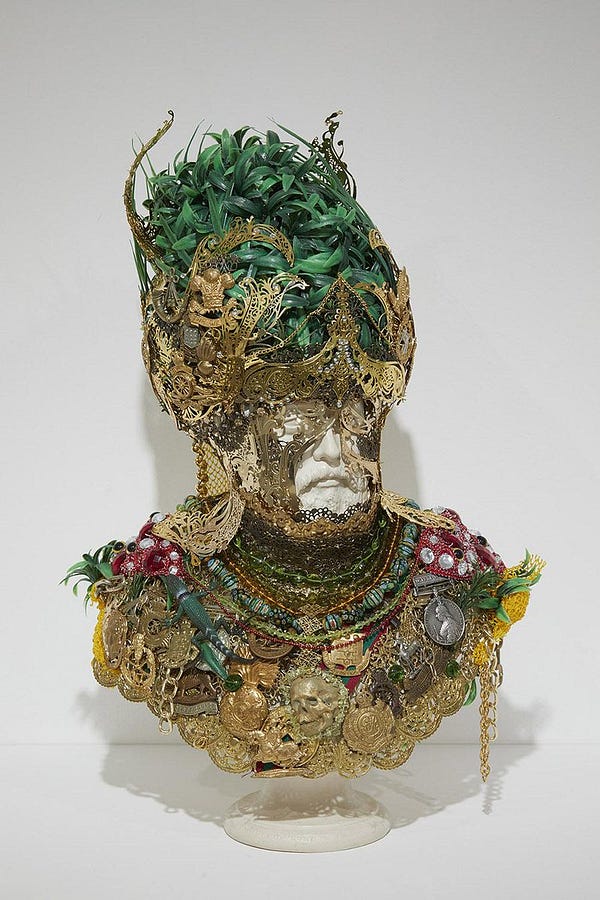
Official Site of Hew Locke / Instagram / Artsy
Renee Cox: An Infinite Spirit (Black Girl Magic), 2016. Mixed media. 76 1/4 × 76 1/2 × 6 in | 193.7 × 194.3 × 15.2 cm.
“A deliberate force in the landscape of contemporary American art for the last three decades, Renee Cox is a photographer and mixed media artist. Where the body is concerned, particularly the black woman’s body, Cox’s gaze has remained at a focused intensity, framing her characteristic self-portraits as poignant arguments on race, desire, religion, feminism and visual and cultural aesthetics. . . . Deeply informed by the cosmology of sacred geometry, particularly the fractal and its presence among many ancient African societies, ‘Soul Culture’ manifests the human body into fantastic sculptural kaleidoscopes, again urging us toward new, if refracted or repeating, consciousness.” (Yale School of Art)


Official Site of Renee Cox / Instagram / Artsy
Sanford Biggers: Everyday a Sunset Dies (LKG), 2014. Antique quilts, assorted textiles, spray paint. 78 x 78 in.
“Sanford Biggers’ work is an interplay of narrative, perspective, and history that speaks to current social, political, and economic happenings while also examining the contexts that bore them. His diverse practice positions him as a collaborator with the past through explorations of often-overlooked cultural and political narratives from American history. Working with antique quilts that echo rumors of their use as signposts on the Underground Railroad, he engages these legends and contributes to this narrative by drawing and painting directly onto them.” (Official Site)


Official Site of Sanford Biggers / Instagram / Artsy
Lina Iris Viktor: Syzygy, 2015. Pure 24K gold, acrylic, print on matte canvas. 40 x 52 in | 101.6 x 132.08 cm.
“Lina Iris Viktor is a conceptual artist, performance artist, and painter. . . . Raised in London to Liberian parents, she traveled extensively in her youth, also living in Johannesburg, South Africa for many years. Her works are a merging of photography, performance and abstract painting, along with the ancient practice of gilding with 24-karat gold to create increasingly dark canvases embedded with ‘layers of light’ in the form of symbols and intricate patterns. Viktor regards these dark canvases to be ‘light-works’.” (Amar Gallery)

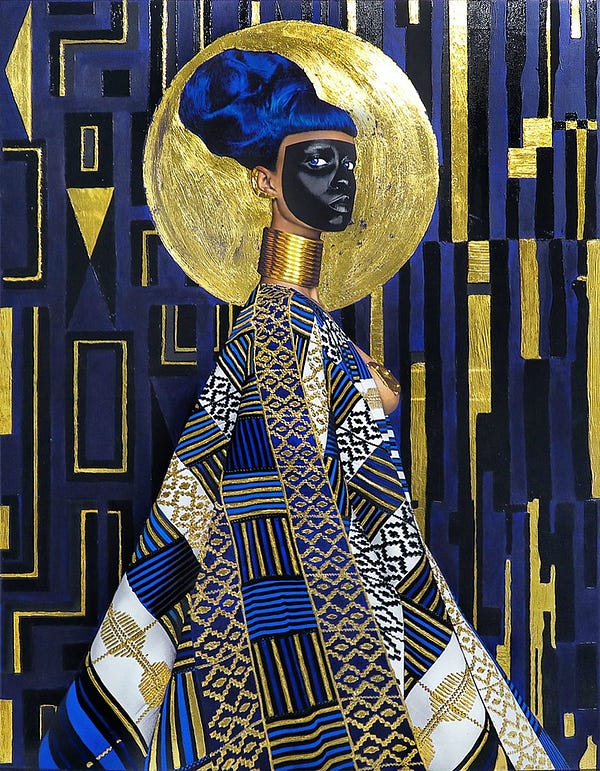
Official Site of Lina Iris Viktor / Instagram / Artsy
Devan Shimoyama: Daphne's Prayer, 2016. Oil, color pencil, spray paint, glitter, collage, and jewelry on canvas. 46 x 38 in.
“Devan Shimoyama is a visual artist working primarily in self-portraiture and narratives inspired by classical mythology and allegory. . . . His compositions are inspired by the work of classical painters such as Caravaggio and Francisco Goya, while adding a more contemporary expression and sensuality. With the use of a variety of lustrous materials such as jewels, black glitter, rhinestones, and sequins, Shimoyama creates works that capture the beauty and alienation of the Black queer body.” (De Buck Gallery)


Official Site of Devan Shimoyama / Instagram / Artsy
Ryan Cosbert: Give Me My Flowers While I Can Smell Them, 2021. Acrylic, glass beads and flower petals on canvas. 60 × 52 in | 152.4 × 132.1 cm.
“Ryan Cosbert is an American painter, installation and mixed media artist whose research based practice focuses on abstract works, along with political and historical narratives. Through color and mixed media, her paintings and sculptures investigate depth and composition as a way to create a relationship between the external and internal implications of the African diaspora. With the painter’s roots of Haitian and Guyanese descent, Cosbert is interested in creating a relationship within the viewer’s reception, in order to provoke and foster a multi-disciplinary dialogue.” (Bode Gallery)
Official Site of Ryan Cosbert / Instagram / Artsy
Paul Lewin: Journey's End, 2021. Acrylic on canvas. 20 x 24 in.
“Working in neutral tones and colors evocative of the tropics, Lewin envisions figures within the speculative realm of Afrofuturism. Geometric motifs and symbols reference diasporic folklore and ritual and adorn the subjects’ faces and torsos. Hoods of fur, snake-like coils, and feathers shroud their bodies, using organic details to frame their silhouettes and convey the intrinsic connections between humanity and nature. Rendered on canvas or wood panel, each work is rooted in the transfer of energy and how legacies are passed through generations.” (Colossal)


Official Site of Paul Lewin / Instagram / Official Art Shop
Firelei Báez: Active Boundaries (July 11), 2012. Ink and acrylic on Yupo synthetic paper. 16 x 16 in | 40.64 x 40.64 cm.
“New York-based artist Firelei Báez casts diasporic histories into an imaginative realm, re-working visual references drawn from the past to explore new possibilities for the future. In exuberantly colorful works on paper and canvas, large-scale sculptures, and immersive installations, Báez combines representational cues that span from hair textures to textile patterns, plantlife, folkloric and literary references, and wide-ranging emblems of healing and resistance.” (James Cohan Gallery)


Firelei Báez at Hauser & Wirth / Instagram / Artsy
Hussein Salim: Ante- chamber, 2020. Acrylic on canvas. 53 1/2 × 41 7/10 in | 136 × 106 cm.
“As a result of the socio-political unrest caused by the First and Second Sudanese Civil Wars, Hussein Salim, along with a million others, was forced to flee his native Sudan and spend a number of years as a refugee in countries like the UK, Germany, Egypt and South Africa. His work, characterised by its use of vibrant colours, the layering of intricate patterns and the impasto painting technique, describes his journey of displacement while celebrating his homeland’s diversity and multicultural communal root.” (The Melrose Gallery)

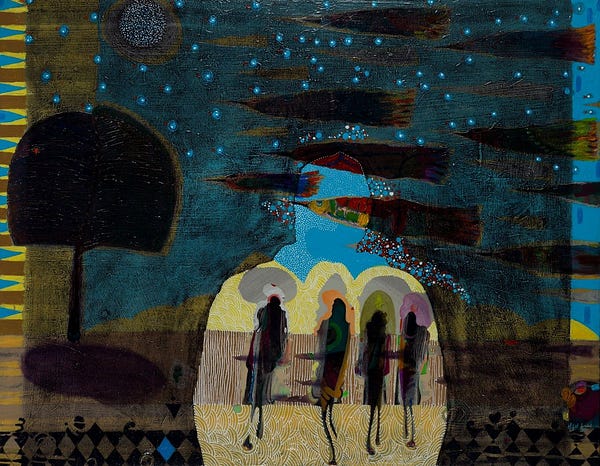
Hussein Salim at The Melrose Gallery/ Instagram / Artsy
Kerry James Marshall: Untitled, 2009. Acrylic on PVC panel. 61 1/8 × 72 7/8 × 3 7/8 in | 155.3 × 185.1 × 9.8 cm.
“Kerry James Marshall (b.1955 in Birmingham, AL; lives and works in Chicago, IL) is recognized as one of the leading contemporary artists of his time. Internationally renowned, Marshall’s work interrogates Western art history—from the Renaissance to 20th-century American Abstraction—challenging and recontextualizing the canon to include themes and depictions that have been historically omitted.” (Jack Shainman Gallery)
Kerry James Marshall at Jack Shainman Gallery / David Zwirner Gallery / Artsy
And there we have it! 28 of our favorite contemporary artists! Tell us in the comments which of these artists inspire you!







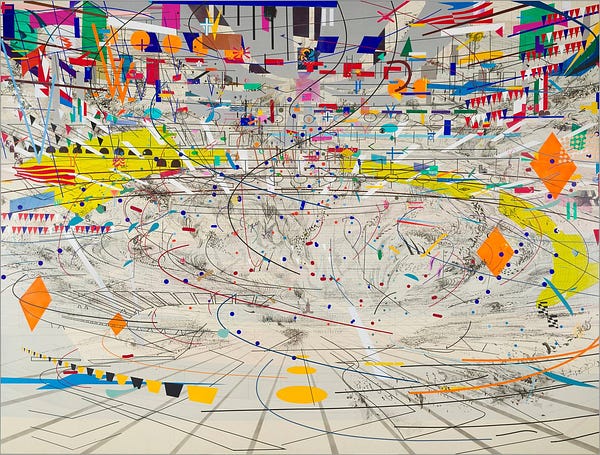

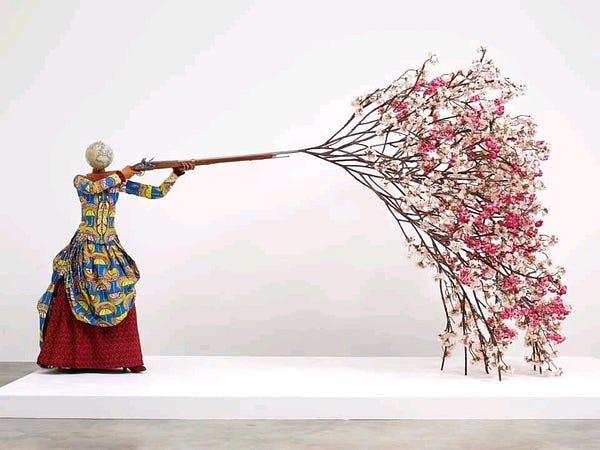



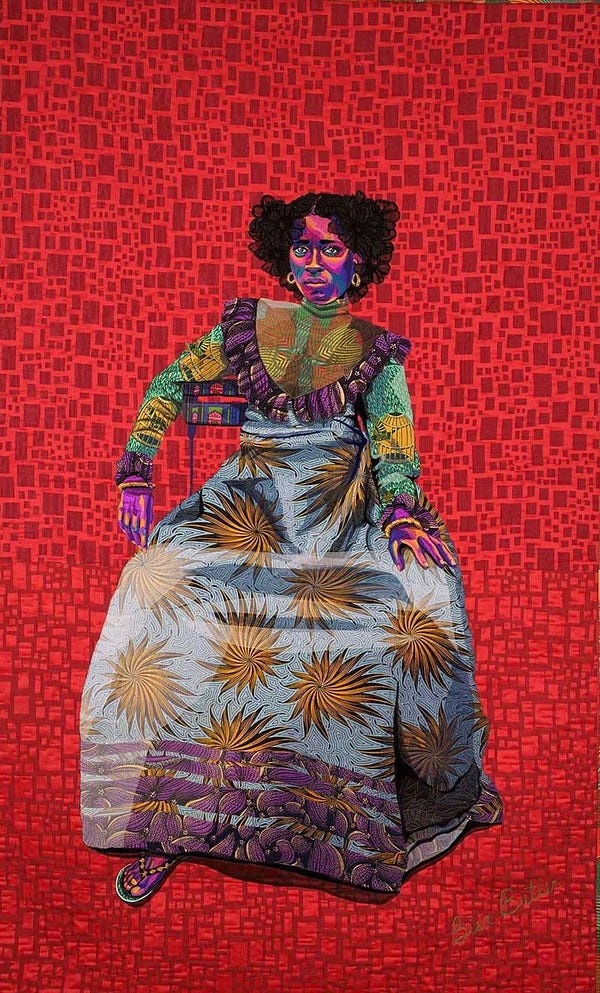

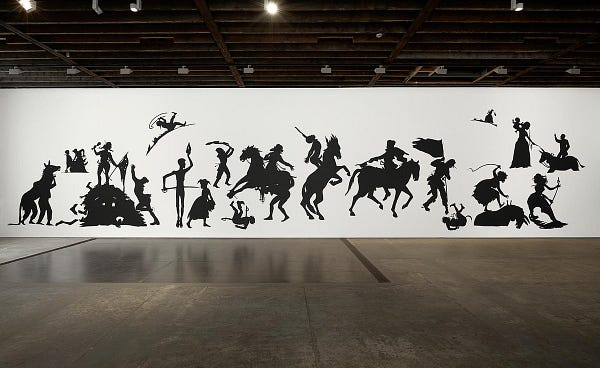


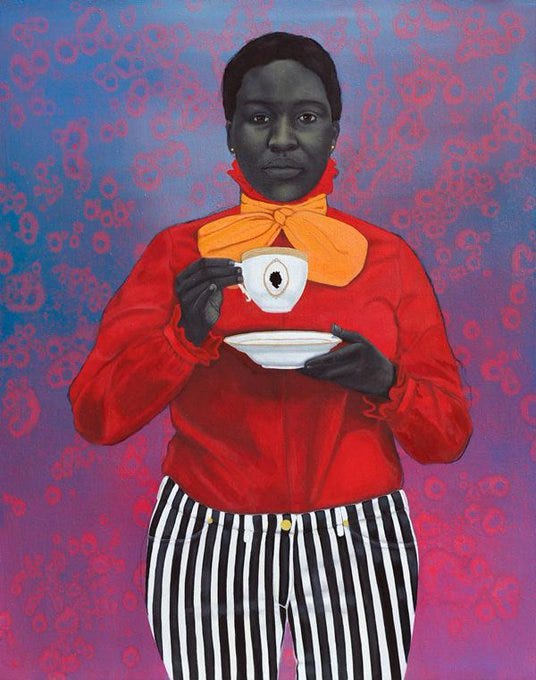


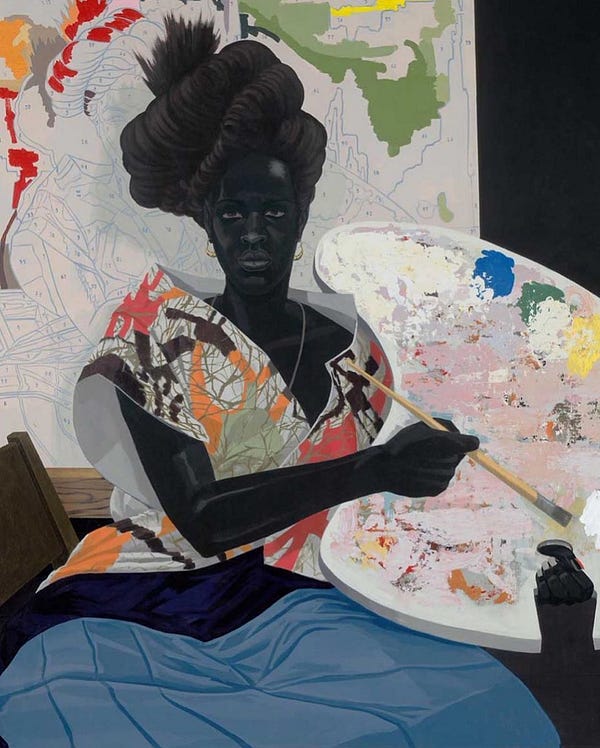
As a textile person, I am inspired by Bisa Butler as well as the Gee's Bend quilters. In addition, if you ever have the chance to experience a Kehinde Wiley exhibition do not hesitate to go--his work is amazing, gigantic, mind blowing, beautiful.